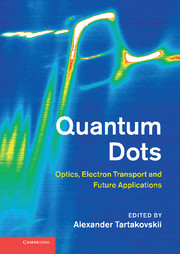Book contents
- Frontmatter
- Contents
- List of contributors
- Preface
- Part I Nanostructure design and structural properties of epitaxially grown quantum dots and nanowires
- Part II Manipulation of individual quantum states in quantum dots using optical techniques
- 4 Studies of the hole spin in self-assembled quantum dots using optical techniques
- 5 Resonance fluorescence from a single quantum dot
- 6 Coherent control of quantum dot excitons using ultra-fast optical techniques: the role of acoustic phonons
- 7 Holes in quantum dot molecules: structure, symmetry, and spin
- Part III Optical properties of quantum dots in photonic cavities and plasmon-coupled dots
- Part IV Quantum dot nano-laboratory: magnetic ions and nuclear spins in a dot
- Part V Electron transport in quantum dots fabricated by lithographic techniques from III–V semiconductors and graphene
- Part VI Single dots for future telecommunications applications
- Index
- References
7 - Holes in quantum dot molecules: structure, symmetry, and spin
from Part II - Manipulation of individual quantum states in quantum dots using optical techniques
Published online by Cambridge University Press: 05 August 2012
- Frontmatter
- Contents
- List of contributors
- Preface
- Part I Nanostructure design and structural properties of epitaxially grown quantum dots and nanowires
- Part II Manipulation of individual quantum states in quantum dots using optical techniques
- 4 Studies of the hole spin in self-assembled quantum dots using optical techniques
- 5 Resonance fluorescence from a single quantum dot
- 6 Coherent control of quantum dot excitons using ultra-fast optical techniques: the role of acoustic phonons
- 7 Holes in quantum dot molecules: structure, symmetry, and spin
- Part III Optical properties of quantum dots in photonic cavities and plasmon-coupled dots
- Part IV Quantum dot nano-laboratory: magnetic ions and nuclear spins in a dot
- Part V Electron transport in quantum dots fabricated by lithographic techniques from III–V semiconductors and graphene
- Part VI Single dots for future telecommunications applications
- Index
- References
Summary
Introduction
The spin projections of single electrons and holes confined in quantum dots (QDs) provide a natural two-level system that can serve as the logical basis for both classical and quantum information processing devices. When two layers of self-assembled InGaAs QDs are grown sequentially, strain propagation causes QDs in the two layers to align along the growth direction. Coherent tunneling of either electrons or holes between the two QDs leads to a variety of Coulomb and spin interactions with possible applications in optoelectronic and logic devices [4, 5, 6, 7, 8, 9, 10, 11, 12, 13, 14, 15]. Because coherent tunneling leads to the formation of delocalized molecular states, these vertically stacked pairs of QDs have come to be known as quantum dot molecules (QDMs). One of the surprising discoveries about QDMs was that the delocalized molecular states have their own unique and tunable properties [16]. In this chapter we review the formation of delocalized molecular states of holes in QDMs and consider how the structure and symmetry of the QDM influence spin properties. Results have been obtained for molecular states charged with one, two, and three holes [9, 13, 17]. We focus here on molecular states occupied by a single hole whose spin projections could serve as the basis for optoelectronic logic devices.
Hole spins were initially discounted for spin-based devices because the complex valence-band interactions were anticipated to degrade spin storage or decoherence times.
- Type
- Chapter
- Information
- Quantum DotsOptics, Electron Transport and Future Applications, pp. 118 - 134Publisher: Cambridge University PressPrint publication year: 2012
References
- 1
- Cited by



